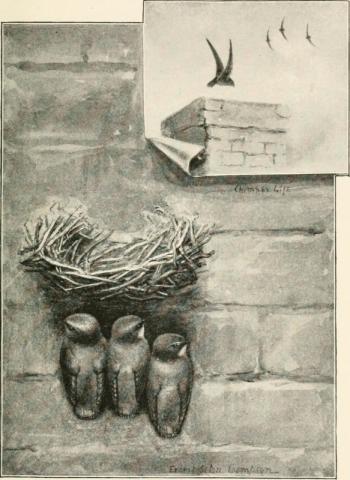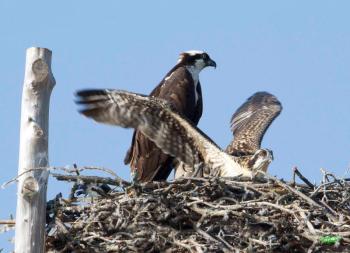No Apologies for a Swift Response
We may have a recent preoccupation with swifts. They seem to have been finding their way into these columns a disproportionate number of times lately as compared to other birds. But we make no apologies—they are a fascinating and mysterious species.
Earlier this week we were sitting on the porch, enjoying the cool of evening, when we heard the familiar chittering of chimney swifts high overhead. We craned our necks to pick them out against the powder blue sky. Two, three, four, five. The number of swirling little gray birds in the flock was at least a dozen, maybe more. Moving that fast they were hard to count.
Why, we wondered, would there be a flock of chimney swifts that large in mid-July? Our best guess was that the flock might be a mix of newly fledged birds and adults watching over them. There may be other explanations, of course, yet that one led us to ponder another question: how do nestling chimney swifts first start flying?
Just the thought seems perilous. Little baby swifts, tucked into tiny stick nests glued to the inside of a dark sooty chimney shaft. What would happen if they jumped from the nest and didn’t get airborne? The bottom of a chimney can’t be a friendly place for any falling thing, certainly not a young flightless bird.
Small birds that nest outside in shrubs and small trees, or on the ground itself, would seem to have a less dangerous and more gradual opportunity to learn the rudiments of flying. We ourselves have seen nestlings recently fledged out of such a nest. They clamber and flap awkwardly from perch to perch inside a thick tangle of bush. Even for them, there are many lethal threats to avoid while gaining flight hours. Cats and hawks may be the most prevalent in our neighborhood. But still, that first flight misstep wouldn’t send them down into the gaping darkness of a deep chimney shaft.
Young ospreys and bald eagles take a long time to mature. Their nests are almost always in very high places, often close to water. Ospreys, which depart the nest about two months after hatching, and bald eagles, which take as much as three months or more, practice flapping and getting the feel of wind under the wings in the weeks before they leave the nest. Despite this, it is not uncommon for the first flight of either species to end on the ground, or worse, in the water. Luckily, more often, young eagles and ospreys can bop around the nest edges or on nearby tree limbs while they gain enough proficiency that their first serious flight will not end in disaster.
Which brings us back to those little nestling chimney swifts.
Young swifts take a bit longer to fledge than many small songbirds. Two to three weeks after hatching, sometimes before they even open their eyes, young swifts scramble out from the nest to cling to the wall of the chimney. There they begin fluttering their wings and eventually are able to make small movements from one spot on the wall near the nest to another.
About a month after hatching, they have developed enough that they can finally let go of the wall, fly up and out of the chimney, and high up into the sky that they have observed as a small patch of blue from the depths of the chimney. It may be anthropomorphizing, but we can’t imagine that there would not be an incredible thrill to the first flight of a chimney swift into a world high above the ground, chittering loudly with mom and dad and the whole chimney swift community.
Those flocks of swifts we saw could be adults and newly fledged young after all. Indeed, the trusty Birds of the World account for chimney swifts tells us that we might be able to distinguish adult from young birds by looking through the flock to see if some individuals have missing and worn feathers (the adults) and some have newly pristine plumage (fledglings). We’ll have to scan closely with the binoculars next time we are on the porch.
Jeffrey V. Wells, Ph.D., is a Fellow of the Cornell Lab of Ornithology and Vice President of Boreal Conservation for National Audubon. Dr. Wells is one of the nation's leading bird experts and conservation biologists. He is a coauthor of the seminal “Birds of Maine” book and author of the “Birder’s Conservation Handbook.” His grandfather, the late John Chase, was a columnist for the Boothbay Register for many years. Allison Childs Wells, formerly of the Cornell Lab of Ornithology, is a senior director at the Natural Resources Council of Maine, a nonprofit membership organization working statewide to protect the nature of Maine. Both are widely published natural history writers and are the authors of the popular books, “Maine’s Favorite Birds” (Tilbury House) and “Birds of Aruba, Bonaire, and Curaçao: A Site and Field Guide,” (Cornell University Press).


..._(28192362852).jpg)






























.png)
.png)
